

Living on generational slave-owner wealth, Martha Daniell Logan was born yesterday in 1704 and became an early botanist in the Carolinas. She collected native plants, exchanged seeds with Britain, and wrote the regular column "Gardener's Kalendar". South Carolina Historical Society. Biographies of Putnam Museum Herbarium Collectors. Adams, Robert P. (1886-1944) Robert Perry Adams (from Solon, Iowa) earned the Bachelor of Science degree from the University of Iowa in 1908 (Sabin et al. 1913) and was pursuing the Master of Science degree from the same institution in 1927 under the guidance of Prof.
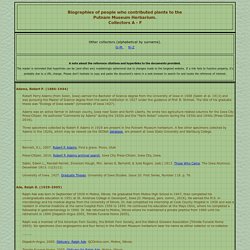
B. Shimek. The title of his graduate thesis was "Ecology of Iowa weeds" (University of Iowa 1927). Adams was an active farmer in Johnson county, Iowa near Solon and North Liberty. Three specimens collected by Robert P. Happy Spring! □Colored engraving, title page of "A Wreath from the Woods of Carolina," Mary Ann Bryan Mason, 1859. Rare Books Collection. Government & Heritage Library. Mary Ann Bryan Mason, 1st woman in NC to have written & illustrated a children. Pope Brown Collection of South Carolina Natural History. The mission of the New York African Free School, founded in 1787, was to educate the young free black population of New York City. These images come from a volume of penmanship & drawing studies completed by the students. #BlackHistoryMonth. Francis Peyre Porcher, 1825-1895. Resources of the Southern Fields and Forests, Medical, Economical, and Agricultural. Being also a Medical Botany of the Confederate States; with Practical Information on the Useful Properties of the Trees, Plants, and Shr.
Leaves generally acid.
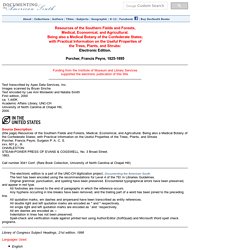
Oxalis acetosella, L. White wood-sorrel. Our History: Huguenots founded area’s horticulture industry - QNS.com. By Joan Brown Wettingfeld A few years ago on a visit to Dublin I passed a small Huguenot cemetery nestled beside a row of restored Georgian houses near St.

Stephen’s Green in the heart of that city. It brought to mind the story of the emigration of French Huguenots to this country and their role in our own local history. In 1660, when the Dutch were attempting to stamp out Quakerism here, a number of French Huguenots settled in Flushing and introduced the industry of horticulture for which this area became famous. “Huguenot” is a term attributed to French Calvinists or Protestants of the 16th and 17th centuries. “Gardener’s Calendar” by Martha Logan – Special Collections. “Gardener’s Calendar” by Martha Logan Martha Daniell Logan (1702-1779) was the first person to publish a gardening calendar in colonial America.
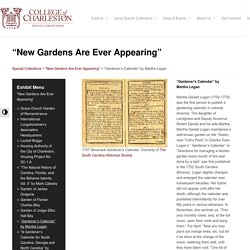
The daughter of Landgrave and Deputy Governor Robert Daniell and his wife Martha, Martha Daniell Logan maintained a well-known garden on the “Green, near Trott’s Point” in Charles Town. Logan’s ” Gardener’s Calendar” or “Directions for managing a kitchen garden every month of the year done by a lady” was first published in the 1752 South Carolina Almanac. Logan slightly changed and enlarged the calendar over subsequent decades. Her byline did not appear until after her death, although the calendar was published intermittently for over fifty years in various almanacs. Ethelind Pope Brown Collection of South Carolina Natural History – Digital Collections. Irvin Department of Special Collections The Ethelind Pope Brown Collection of South Carolina Natural History is comprised of 32 opaque watercolors, or gouaches, on paper.
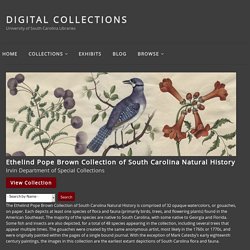
Each depicts at least one species of flora and fauna (primarily birds, trees, and flowering plants) found in the American Southeast. “A Gardener’s Calendar for South Carolina, Georgia and North Carolina” by Robert Squibb – Special Collections. “A Gardener’s Calendar for South Carolina, Georgia and North Carolina” by Robert Squibb, 1787 Squibb made the transatlantic journey from England to Charleston in 1780.

By 1785, Squibb had leased a large plot of ground on Meeting Street near Rumney Bridge and was operating a nursery. Advertisements for his nursery appeared regularly in the South Carolina Gazette. In 1787, Squibb published The Gardener’s Calendar which followed a format commonly found in 18th century British and French gardening texts and was written to be read chronologically by month serving as a planting guide for gardeners in the South. The Gardener’s Calendar tells the reader in detail not only what to plant each month of the year, but how to cultivate properly for the best possible results.
Dr William Porcher (1800-1833) Ophir Plantation - Lake Moultrie, Berkeley County, South Carolina SC. Fungi of Carolina, natural specimens of the species (1852), Page 1 - Henry William Ravenel Papers, 1739-1935 - CONTENTdm Title. Julian John Chisolm: Class of 1850, Civil Practice to Civil War: The Medical College of the State of South Carolina 1861-1865. Julian John Chisolm, M.D., n.d.
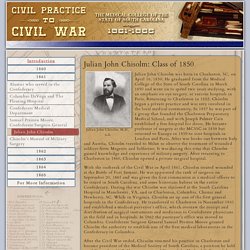
Julian John Chisolm was born in Charleston, SC, on April 16, 1830. He graduated from the Medical College of the State of South Carolina in March 1850 and went on to spend two years studying, with an emphasis on eye surgery, at various hospitals in Paris. Returning to Charleston in 1852, Chisolm began a private practice and was very involved in the local medical community. In 1857 he was part of a group that founded the Charleston Preparatory Medical School, and with Joseph Palmer Cain established a free hospital for slaves. He became professor of surgery at the MCSSC in 1858 but returned to Europe in 1859 to visit hospitals in London and Paris.